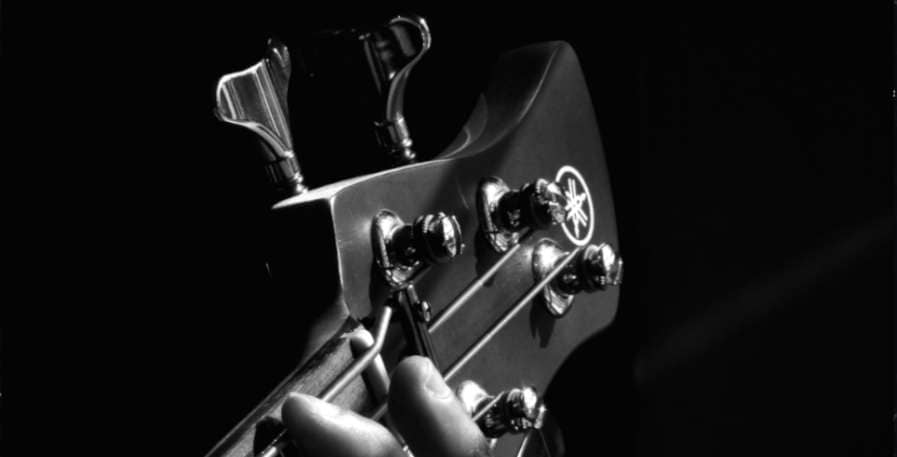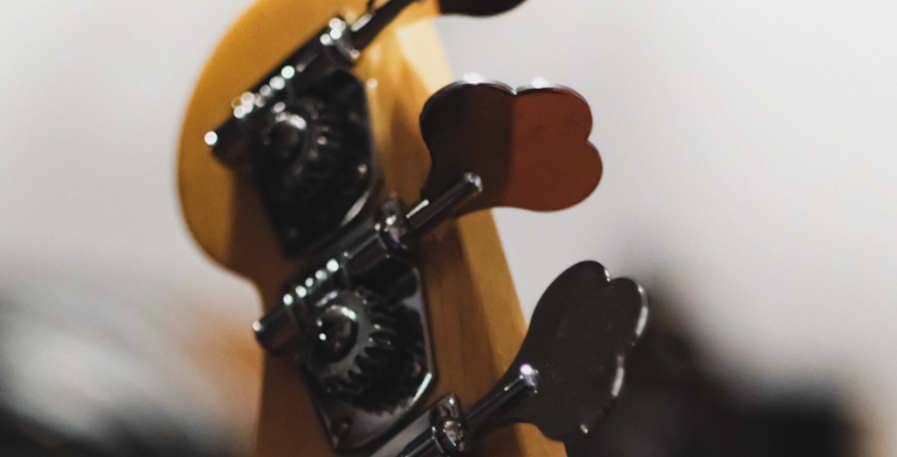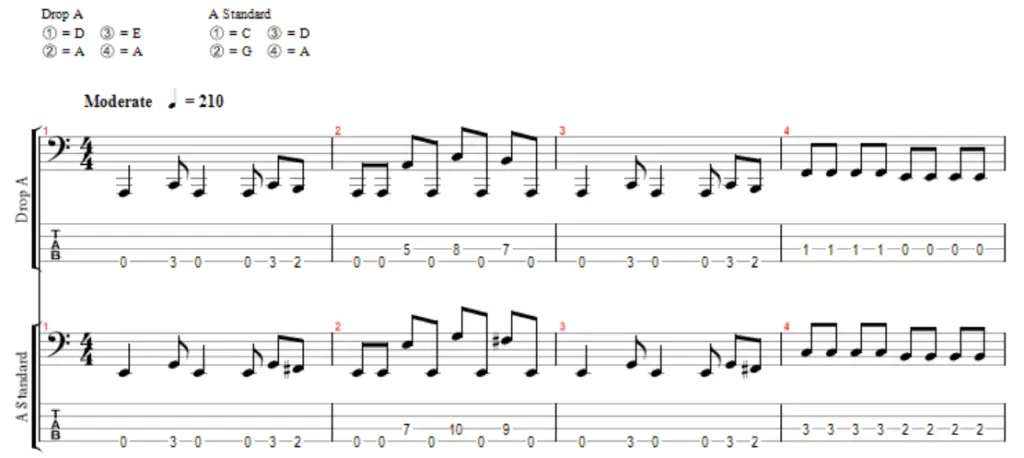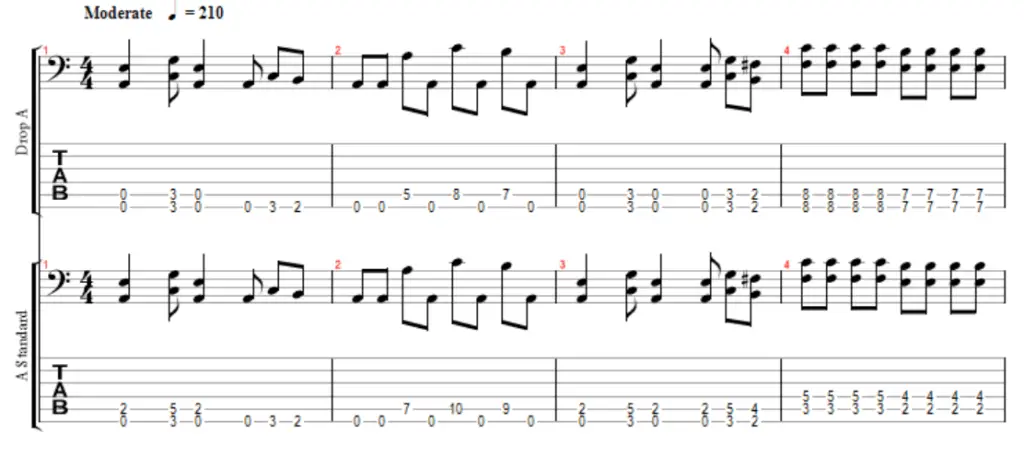This post contains affiliate links.
Bassists that tune their basses to Drop A usually play heavy sub-genres of rock and metal. This comes as no surprise, as Drop A is one of the deepest tunings that basses can realistically be tuned down to.
This tuning can sound incredibly heavy and brutal when used to its full potential, as many Death Metal, Deathcore, and Metalcore bands have shown. However, tuning your bass to Drop A is not as easy just turning the tuning knobs. At least if you want your instrument to retain its tone and playability.
That`s why I`ve written this guide to teach you everything you need to know about this tuning. I will show you how to set up your bass for it and what strings to choose. I`ve also made a tuner that you can use to easily tune your 4, 5, or 6-string bass to A.
Furthermore, I will showcase some bands that play in Drop A, and show you the pros and cons of it when compared to other alternate tunings.
What is Drop A tuning on a bass?
A bass tuned to drop A is the same as a bass tuned to B standard with the heaviest string tuned down a whole step to A. For 4-string basses this results in an A-E-A-D tuning, Drop A tuning for a 5-string bass has the strings tuned to A-E-A-D-G.
Let`s start by going over the main reasons you`d want to choose this tuning, and why to choose it over other options:
- Heaviness: The most common reason that bassists tune down their instruments is to sound heavier. Most bands tune this low to play sub-genres of metal with a big emphasis on sounding as heavy as possible. It pushes the envelope in terms of how low you can go, and riffs in drop A can sound significantly more brutal than they would in drop D.
- Standing out: Most bands play in E standard. Bands that tune down most commonly tune to Drop D or to Drop C. Thus, by tuning to drop A instead, you will sound different from the vast majority of artists out there. This uniqueness will help in catching people’s attention and blowing them away on recordings and during live shows.
- 1-finger power chords: As with most common drop tunings, drop A allows guitarists and bassists to play power chords with just one finger. This is because the A and E strings are tuned a perfect fifth apart, rather than a perfect fourth. This is more relevant for guitar players, as bass chords will sound incredibly muddy when played at these frequencies. However, bassists might still tune to drop A in bands where the guitarists chose this tuning. This makes it easier to communicate ideas, share riffs and be on the same page.
- The drop D of 5 string-basses: Drop D is not only a great sounding tuning, but it is also convenient for 4-string bassits and 6-string guitar players as they only need to tune 1 string 1 whole step down. For 5-string basses and 7-string guitars that are commonly tuned to B, Drop A works the same way. The tuning thus allows for the option of a significantly heavier sound by just tuning 1 string down.

Can you tune a 4 string bass to drop A?
In general, 4-string basses can be tuned to Drop A without issue, given that they get set up correctly. While less the tuning can be less convenient than on 5 and 6-string basses, there are a multitude of bassists that have played in Drop A on a 4-string bass.
It is not uncommon to see bassists that play in Drop A use 4-string basses. A couple that comes to mind is Ted Lundström of Amon Amarth and Gabe Crisp of White Chapel.
Related reading: Do you need a 5 string bass for metal?
Thus, as long as you set up the bass correctly for the tuning, 4-string basses will usually be playable in Drop A.
The reason I say usually is that some poor-quality entry-level instruments might not sound that great in it. This will rarely be an issue, but it is something to be mindful of if the bass you are tuning down is poorly built or if it has existing intonation issues.
Setup and preperation
When tuning a 4-string bass to drop A, I highly recommend setting it up for the tuning. This is less important for 5 and 6-string basses, but it is still a best practice to do so if you intend to keep the instrument tuned down.
Regardless of what type of bass you play I thus recommend going over the steps below to avoid intonation issues, and to ensure that the tone and playability of your instrument are optimized:
- Get an A string: You will need a thick enough string to handle the tension required for the low A to sound heavy and resonant. If the string gauge is too thin, the A string will sound sloppy and powerless. Generally, this is the only additional string you will need. This is because 4, 5, and 6-string basses in their respective standard tuning already have string gauges that are perfect for Drop A. I will cover string choice more in-depth further down. The short answer is that I recommend this .145 string for the low A.
- Filing the nut: To fit the thicker string mentioned above, you will likely need to file the nut on your bass. 5 and 6-string players might get away with not doing it, or they will need to file the nut slightly to fit the A string. 4-string players will generally need to file every cut in the nut. This is because every string has to be moved one spot deeper. For example, your E string will now need to fit in the nut slot originally intended for the A string. Thus, the string will not fit in the nut without filing it down slightly in most cases.
- Adjusting action: When switching strings and setting up your bass, the action on your bass will generally rise. While some bassits like higher action because it provides better sustain, this comes at the cost of playability. Therefore, bassists generally prefer lower action. I also recommend prioritizing lower action over sustain if you are looking to play heavier genres of metal. This is because you will need your instrument to feel easy to play when dishing out heavy and fast riffs. Adjusting the action yourself is both quick and easy.
- Adjusting neck relief: Lastly, with heavier strings, the tension on the neck will likely change. 5 and 6-string will only notice this to a small degree. 4-string players, on the other hand, can expect a large difference in tension. Similar to adjusting the action, neck relief can be adjusted on your own.
Setting up your bass is fast, and these are all steps that can be performed at home. If you feel uncomfortable with this though, you can also take your bass to a luthier to get it set up.
Related reading: Average cost of a bass setup.

How do you tune a bass to drop A?
Below is a tuner that you can use to tune 4, 5, and 6-string basses to drop A.
Given that we are dealing with very low frequencies at this point, you might struggle to hear the pitch perfectly. What helps me is to rely on “feel” for the A string. While it can be hard to hear the pitch perfectly, the A string will “feel” harmonious with the note from the tuner when it`s at the right pitch.
A: (Deepest string on 4, 5, and 6-string basses)
E:
A:
D:
G: (For 5 and 6-string basses)
C: (For 6-string basses)
If you find this difficult, I recommend this online bass tuner which uses a microphone. It will show you exactly what pitch is being played at all times.
The microphone might struggle to pick up the deepest string due to how low it is. If this happens, play it at the 12th fret, as it will be easier for the microphone to pick up. This note should be an A1 on 4, 5, and 6-string basses.
What strings are best for Drop A?
String gauges of .145-.105-.85-.70, with an added .50 for 5-string basses, and an added .40 for 6-string basses make for a balanced set for Drop A. Using roundwound strings ensures that the tone of your bass is both bright and heavy.
5-string sets typically come with a .130 gauge string for the low B. It is possible to tune it down to A, but it will feel somewhat sloppy and lack some of the punch it could have with a heavier gauge.
This is because at deeper frequencies it becomes more demanding for strings to maintain a resonant tone and a playable tension. When tuning from B0 to A0, one whole note can thus make a world of difference.
Therefore, I recommend a .145 gauge string for the low A. You do have a lot of flexibility with how you want to set up this string and I`ve seen bassists use everything from a .160 to a .135. However, I find the .145 and to strike a nice balance between tension, playability, and heaviness.
The great thing about tuning a bass to drop A is that you can make use of strings that are intended for B and E standard. For 4-string basses, you will need a single heavy string for the A. However, the E, A, and D, strings in a standard gauge set can all be reused one step higher up on the nut. The G string will not be needed and should be stored away.
For 5-string basses, you don`t need to move a standard set of strings up. The E, A, D, and G strings are already tuned to Drop A. However, I do recommend switching the B string out with a heavier gauge before you tune it down to A. The same goes for 6-string basses.
Thus, regardless of whether you play a 4, 5, or 6-string bass, all you need is a .145 single string to tune to drop A. My recommendation is D’Addario`s Roundwound ProSteels. This string has a good bit of brightness which will ensure that your A string has a lot of character while playing heavy grooves.

Which bands play in drop A?
Most bands that tune to Drop A play heavy sub-genres of metal. This comes as no surprise as the tuning allows for an incredibly heavy sound, which would sound excessively deep in most genres.
Various metal acts have made great use of the tuning in various ways. Drop A has been used to create some of the heaviest breakdowns you will ever hear. At the same time, it has been used to create a hard-hitting backdrop for guitar harmonies by more melodic bands.
Below is a list of various bands that have played in Drop A. Most of these bands have changed their sound and explored various genres throughout their career. Thus, consider their genre labels as a surface-level description of their style.
| Band | Bassist | Genre | Notable Songs in Drop A |
| Slipknot | Paul Gray (1995-2010), Alessandro Venturella (since 2014) | Alternative Metal | Psychosocial, The Devil in I |
| Amon Amarth | Ted Lundström | Melodic Death Metal | Guardians Of Asgaard, Raise Your Horns |
| Nile | Various. Chief Spires (1993–2001), Brad Parris (since 2015) | Technical Death Metal | Lashed To The Slave Stick, Cast Down The Heretic |
| Whitechapel | Gabe Crisp | Deathcore | The Somatic Defilement, Death Becomes Him |
| Suicide Silence | Mike Bodkins (2002-2008), Dan Kenny (2008 onward) | Deathcore | Destruction Of A Statue, Wake Up |
| Motionless In White | Various. Justin Morrow (since 2019) | Metalcore | Black Damask The Fog, Devils Night |
| Jinjer | Eugene Abdukhanov | Metalcore | I Speak Astronomy, Teacher Teacher |
| Bring Me the Horizon | Matt Kean | Metalcore | Heavy Metal, Can You Feel My Heart (ver 6) |
| Ektomorf | Various. Csaba Farkas (1994–2008), Csaba Zahorán (since 2018) | Groove Metal | Stigmatized, Never Should |
| Thy Art Is Murder | Various. Josh King (2006-2009), Kevin Butler (since 2014) | Deathcore | The Son Of Misery, Soldiers Of Immortality |
Drop A VS A Standard
In A Standard, a 4-string bass is tuned to A-D-G-C. 5 string basses are tuned to A-D-G-C-F.
The advantage of A standard is the same as that of every standard tuning. Strings are tuned a perfect fourth apart, which always allows for easy access to notes when utilizing all 4 fingers on your fretting hand.
It also retains your knowledge and mastery of the fretboard if you are used to playing in a different standard tuning. Any bass groove that you can play in E can be played the same way in A standard too, it will simply be in a different key and pitch.
Drop A is essentially just B standard with a larger gap in pitch between the A and E strings. This will take a little bit of getting used to, but will ultimately be inconsequential for playing a vast majority of metal riffs:

However, for guitarists, this difference can make a world of difference. With the deepest two strings tuned to A and E, power chords become significantly easier to play. When playing fast chord progressions, this can be extremely helpful:

What this means for you as a bass player, is that you will need to make a choice as to what tuning to choose if you play in a band with guitarists that use a drop tuning.
While you don`t have to play in the same tuning, I do generally recommend it. This is because sharing ideas and riffs becomes easier and you won`t have to transpose riffs. Most importantly, it ensures that you are all on the same page, which is never to be taken for granted when playing in a band.
Conclusion
By tuning your bass to Drop A the right way, you might get surprised at how powerful your instrument can sound. To me, plucking that open string for the first time after tuning down is one of the most satisfying feelings there is.
I recommend this tuning for anyone who wants to sound as heavy as possible while retaining the playability of your instrument. It is possible to tune deeper, but below A things start to get a little tricky when it comes to string tension and keeping strings fretable.
The most important thing to do is to get thick enough strings and to set up your bass. For both 4 and 5-string players, a string in the .140 to .160 range will do for the low A. Personally, I recommend a .145, and I find that roundwound strings are the best fit for this tuning and heavy sub-genres in general.
Setting your bass up can easily be done at home. If you don`t want to do it yourself, I highly recommend paying a luthier to do it rather than skipping this step.
As long as you take care of that part, your bass is going to sound heavier than it ever has before. If you have never tuned this low before, I can say from experience that you have something to look forward to.
Metal bassists tend to tune down their instruments, have a powerful tone, and sometimes even use distortion. Yet, the bass can often be hard to hear in mixes. That`s why I wrote an article on the reason you can`t hear the bass in metal.

